 W
WThe military history of Canada during World War I began on August 4, 1914, when the United Kingdom entered the First World War (1914–1918) by declaring war on Germany. The British declaration of war automatically brought Canada into the war, because of Canada's legal status as a British Dominion which left foreign policy decisions in the hands of the British parliament. However, the Canadian government had the freedom to determine the country's level of involvement in the war. On August 4, 1914, the Governor General declared a war between Canada and Germany. The Militia was not mobilized and instead an independent Canadian Expeditionary Force was raised.
 W
WThe military history of Canada during World War I began on August 4, 1914, when the United Kingdom entered the First World War (1914–1918) by declaring war on Germany. The British declaration of war automatically brought Canada into the war, because of Canada's legal status as a British Dominion which left foreign policy decisions in the hands of the British parliament. However, the Canadian government had the freedom to determine the country's level of involvement in the war. On August 4, 1914, the Governor General declared a war between Canada and Germany. The Militia was not mobilized and instead an independent Canadian Expeditionary Force was raised.
 W
WBarton Mine, also known as Net Lake Mine, is an abandoned surface and underground mine in Northeastern Ontario, Canada. It is located about 0.50 km (0.31 mi) north of the Temagami Arena in Temagami North and just east of the Ontario Northland Railway in northwestern Strathy Township. Dating back to the early 1900s, it is one of the oldest mines in Temagami. Barton was the site of a fire in the early 1900s, after which it never had active mining again.
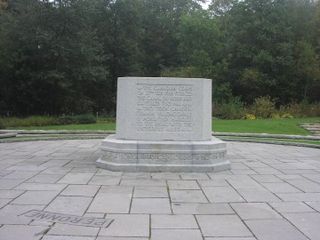 W
WThe Bourlon Wood Memorial, near Bourlon, France, is a Canadian war memorial that commemorates the actions of the Canadian Corps during the final months of the First World War; a period also known as Canada's Hundred Days, part of the Hundred Days Offensive.
 W
WThe Canadian National Vimy Memorial is a war memorial site in France dedicated to the memory of Canadian Expeditionary Force members killed during the First World War. It also serves as the place of commemoration for Canadian soldiers of the First World War killed or presumed dead in France who have no known grave. The monument is the centrepiece of a 100-hectare (250-acre) preserved battlefield park that encompasses a portion of the ground over which the Canadian Corps made their assault during the initial Battle of Vimy Ridge offensive of the Battle of Arras.
 W
WThe Canadian Siberian Expeditionary Force was a Canadian military force sent to Vladivostok, Russia, during the Russian Revolution to bolster the allied presence, oppose the Bolshevik Revolution and attempt to keep Russia in the fight against Germany. Composed of 4,192 soldiers and authorized in August 1918, the force returned to Canada between April and June 1919. The force was commanded by Major General James H. Elmsley. During this time, the C.S.E.F. saw little fighting, with fewer than 100 troops proceeding "up country" to Omsk, to serve as administrative staff for 1,500 British troops aiding the anti-Bolshevik White Russian government of Admiral Alexander Kolchak. Most Canadians remained in Vladivostok, undertaking routine drill and policing duties in the volatile port city.
 W
WThe Castle Mountain Internment Camp, located in Banff National Park, Alberta, was the largest internment facility in the Canadian Rockies, housing several hundred prisoners at any one time. Established on July 13, 1915, a total of 660 enemy aliens were interned at the facility during its entire operation.
 W
WThe Conscription Crisis of 1917 was a political and military crisis in Canada during World War I. It was mainly caused by disagreement on whether men should be conscripted to fight in the war, but also brought out many issues regarding relations between French Canadians and English Canadians. Almost all French Canadians opposed conscription; they felt that they had no particular loyalty to either Britain or France. Led by Henri Bourassa, they felt their only loyalty was to Canada. English Canadians supported the war effort as they felt stronger ties to the British Empire. On January 1, 1918, the Unionist government began to enforce the Military Service Act. The act caused 404,385 men to be liable for military service, from which 385,510 sought exemption.
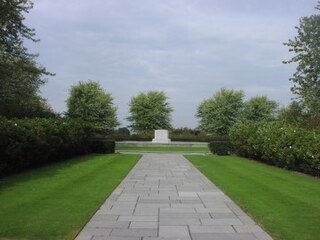 W
WThe Courcelette Memorial is a Canadian war memorial that commemorates the actions of the Canadian Corps in the final two and a half months of the infamous four-and-a-half-month-long Somme Offensive of the First World War. The Canadians participated at the Somme from early September to the British offensives end in mid-November 1916, engaging in several of the battles-within-the-battle of the Somme, including actions at: Flers-Courcelette, Thiepval Ridge, the Ancre Heights, the Ancre as well as a small role in providing relief to the First Australian Imperial Force in the final days of the Battle of Pozières. The battles on the Somme were the first in which all four Canadian divisions participated in the same battle, although not together in a cohesive formation. The Canadian divisions suffered over 24,000 casualties.
 W
WThe Courtrai Memorial is a Dominion of Newfoundland war memorial in Kortrijk, Belgium that commemorates the actions of the Royal Newfoundland Regiment during the First World War when it served and fought in several campaigns in Belgium from 1916 to 1918.
 W
WThe Dury Memorial is a World War I Canadian war memorial that commemorates the actions of the Canadian Corps in the Second Battle of Arras, particularly their breakthrough at the Drocourt–Quéant Line switch of the Hindenburg Line just south of the town of Dury, Pas-de-Calais, France.
 W
WThe Guelph Raid was an incident that occurred at the St. Stanislaus Novitiate in Guelph, Ontario in 1918. While the novitiate was attended by the son of the Justice Minister of Canada, Charles Doherty, Canadian military officers surrounded it attempting to enforce the Military Service Act, causing a Royal Commission to be appointed by the Parliament of Canada in April 1919.
 W
WThe Gueudecourt Memorial is a Dominion of Newfoundland war memorial that commemorates the actions of the Royal Newfoundland Regiment during the Battle of Le Transloy, a sub-battle of the Battle of the Somme of World War I. Located about 1-kilometre (0.62 mi) north-east of Gueudecourt village, the memorial marks the spot where in October 1916, the Royal Newfoundland Regiment played a decisive role in the capture and holding of a German strong-point. The site also marks the furthest point of advance from the July 1st starting line of all British units during the Battle of the Somme.
 W
WThe Canadian Hill 62 Memorial is a war memorial that commemorates the actions of the Canadian Corps in defending the southern stretches of the Ypres Salient between April and August 1916 including actions in battle at the St Eloi Craters, Hill 62, Mount Sorrel and Sanctuary Wood. These battles marked the first occasion in which Canadian divisions engaged in planned offensive operations during World War I. In those actions the Canadians reconquered vital high-ground positions that denied the Germans a commanding view of the town of Ypres itself.
 W
WThe Le Quesnel Memorial is a Canadian war memorial that commemorates the actions of the Canadian Corps during the 1918 Battle of Amiens during World War I. The battle marked the beginning of a 96-day period known as "Canada's Hundred Days" that saw the crumbling of the German Army and ultimately the Armistice that ended the war. The memorial is located just to the southwest of the village of Le Quesnel, on the road between Amiens and Roye, in northern France.
 W
WThe Capture of Le Sars was a tactical incident during the Battle of the Somme. Le Sars is a commune in the Pas-de-Calais department in the Nord-Pas-de-Calais region of France. The village lies along the Albert–Bapaume road. The village is situated 16 mi (26 km) south of Arras, at the junction of the D 11 and the D 929 roads. Courcelette lies to the south, Pys and Miraumont to the north-west, Eaucourt l'Abbaye to the south-east, the Butte de Warlencourt is to the north-east and Destremont Farm is south-west.
 W
WThe Masnières Newfoundland Memorial is a Dominion of Newfoundland war memorial that commemorates the actions of the Royal Newfoundland Regiment during the First Battle of Cambrai, of World War I. Located at the north end of the town of Masnières, France, the memorial commemorates the participation of the Newfoundlanders in the taking and defense of the town during the First Battle of Cambrai between 20 November and 2 December 1917.
 W
WThe Military Service Act, 1917 was an act passed by the Parliament of Canada in an effort to recruit more soldiers.
 W
WThe National War Memorial, titled The Response is a tall, granite memorial arch with accreted bronze sculptures in Ottawa, Ontario, Canada, designed by Vernon March and first dedicated by King George VI in 1939. Originally built to commemorate the Canadians who died in the First World War, it was in 1982 rededicated to also include those killed in the Second World War and Korean War and again in 2014 to add the dead from the Second Boer War and War in Afghanistan, as well as all Canadians killed in all conflicts past and future. It now serves as the pre-eminent war memorial of 76 cenotaphs in Canada. In 2000, the Tomb of the Unknown Soldier was added in front of the memorial and symbolizes the sacrifices made by all Canadians who have died or may yet die for their country.
 W
WThe No. 2 Construction Battalion, Canadian Expeditionary Force (CEF), was raised in Nova Scotia and was one of two predominantly black battalions in Canadian military history and the only Canadian battalion composed of black soldiers to serve in World War I. Commanded by Lieutenant Colonel D.H. Sutherland, formerly of the 193rd Battalion, CEF, all but one of the unit's 19 officers were white, the exception being Captain William A. White, the unit's Chaplain.
 W
WThe Passchendaele Canadian Memorial is a Canadian war memorial that commemorates the actions of the Canadian Corps in the Second Battle of Passchendaele of World War I. The memorial is located on the former site of Crest Farm, an objective captured by the 4th Canadian Division during the assault of 30 October 1917.
 W
W"Princess Pat" is a 1917 North American song, popular to sing at campfires. It began as a military cadence of Princess Patricia's Canadian Light Infantry.
 W
WThe St. Julien Memorial is a Canadian war memorial and small commemorative park located in the village of Saint-Julien, Langemark, Belgium. The memorial commemorates the Canadian First Division's participation in the Second Battle of Ypres of World War I which included fighting in the face of the first poison gas attacks along the Western Front. Frederick Chapman Clemesha's sculpture, the Brooding Soldier, was selected to serve as the central feature of the monument following a design competition organized by the Canadian Battlefield Monument Commission in 1920.
 W
WThe Sanctuary Wood Museum Hill 62, 3 km (1.9 mi) east of Ypres, Belgium is a private museum located in the neighbourhood of the Canadian Hill 62 Memorial and the Sanctuary Wood Cemetery.
 W
WThe Ukrainian Canadian internment was part of the confinement of "enemy aliens" in Canada during and for two years after the end of the First World War, lasting from 1914 to 1920, under the terms of the War Measures Act.
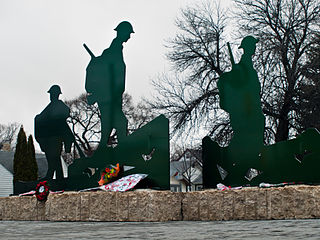 W
WValour Road is a 3-kilometre (1.9 mi) street in the West End area of Winnipeg, Manitoba, Canada. Originally called Pine Street, it was renamed Valour Road in 1925 to recognize three young men—Corporal Leo Clarke, Sergeant-Major Frederick William Hall, and Lieutenant Robert Shankland—who all lived in the 700-block and individually received the Victoria Cross for acts of bravery during the First World War.
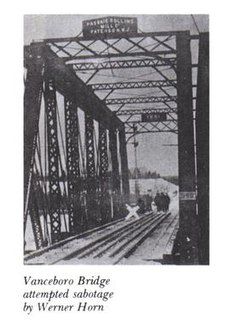 W
WThe 1915 Vanceboro international bridge bombing was an attempt to destroy the Saint Croix-Vanceboro Railway Bridge on February 2, 1915, by Imperial German spies.
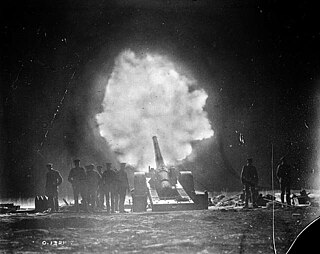 W
WThe Battle of Vimy Ridge was a military engagement fought as part of the Battle of Arras, in the Nord-Pas-de-Calais region of France, during the First World War. The main combatants were the Canadian Corps against three divisions of the German Sixth Army. The battle was part of the opening phase of the Battle of Arras, part Nivelle Offensive and took place from 9–12 April 1917. The objective of the Canadian Corps was to take control of the German-held high ground, along an escarpment at the northernmost end of the Arras Offensive. This would ensure that the southern flank could advance without suffering German enfilade fire.